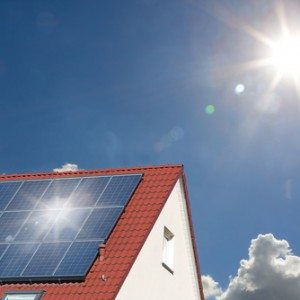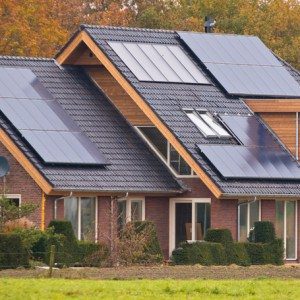 One of the beauties of solar power is that, once installed, solar panels require little maintenance throughout their rated lifetime. The initial startup cost of installation can be a deterrent for many homeowners, but in reality, the monthly energy savings pay back the installation costs relatively quickly. With limited maintenance costs, solar panels really are strong long-term investments.
In general, photovoltaic (PV) systems come with a 20-year warranty and a guarantee that the solar panels will continue to produce at least 80% of their rated power after the initial 20-year period. Solar panel durability has improved in lockstep with improvements in PV technology and manufacturing, however, so a solar panel produced after the year 2000 will only degrade by 0.4% a year. At this rate, it will retain 92% of its original efficiency after 20 years. Yet, even with this minimal degradation, there are some basic maintenance tasks that can be done to reduce the wear and tear on the panels and maintain high efficiency throughout the lifetime of the system.
Homeowners with solar panel installations should be primarily concerned with keeping the panels free of dirt and debris. This will be a bigger problem in systems with flat-lying panels, as opposed to those oriented at an angle. Anything that covers the panels will reduce the electrical output of the system, so it is important to not let some dust reduce the efficiency of the system. In most cases, simply spraying the solar panels with a hose will suffice, but you could also use a sponge on a pole to squeegee the panels and remove any stickier items, like bird droppings. Many solar companies also offer cleaning services and there are cleaning supplies available for purchase on the internet.
Similar to keeping the panels clear, it is important to ensure clear access to sunlight. Solar access could be impeded by overgrown vegetation or new structures, so always keep an eye on what’s happening south of the installation. It may be necessary to trim back some trees or talk to your neighbor so they don’t block your sunlight.
Solar panels are more susceptible in harsh climates, particularly those that experience heavy snowfall, strong winds, or frequent hail. If space and the angle of the panels permit, homeowners may consider erecting a buffer to protect the panels from the worst of the climate. Reducing the direct impact to the solar panels will extend their lifetime and improve efficiency.
There are other, rarer, things to look out for as well. Ideally, your solar panels will not much that can fall on them, but there could be instances when they are damaged by hail, or falling sticks, or a rogue cat. Keep an eye out for broken glass on the top of the panels; if there is broken glass the solar panel could be compromised and will need to be replaced.
One of the beauties of solar power is that, once installed, solar panels require little maintenance throughout their rated lifetime. The initial startup cost of installation can be a deterrent for many homeowners, but in reality, the monthly energy savings pay back the installation costs relatively quickly. With limited maintenance costs, solar panels really are strong long-term investments.
In general, photovoltaic (PV) systems come with a 20-year warranty and a guarantee that the solar panels will continue to produce at least 80% of their rated power after the initial 20-year period. Solar panel durability has improved in lockstep with improvements in PV technology and manufacturing, however, so a solar panel produced after the year 2000 will only degrade by 0.4% a year. At this rate, it will retain 92% of its original efficiency after 20 years. Yet, even with this minimal degradation, there are some basic maintenance tasks that can be done to reduce the wear and tear on the panels and maintain high efficiency throughout the lifetime of the system.
Homeowners with solar panel installations should be primarily concerned with keeping the panels free of dirt and debris. This will be a bigger problem in systems with flat-lying panels, as opposed to those oriented at an angle. Anything that covers the panels will reduce the electrical output of the system, so it is important to not let some dust reduce the efficiency of the system. In most cases, simply spraying the solar panels with a hose will suffice, but you could also use a sponge on a pole to squeegee the panels and remove any stickier items, like bird droppings. Many solar companies also offer cleaning services and there are cleaning supplies available for purchase on the internet.
Similar to keeping the panels clear, it is important to ensure clear access to sunlight. Solar access could be impeded by overgrown vegetation or new structures, so always keep an eye on what’s happening south of the installation. It may be necessary to trim back some trees or talk to your neighbor so they don’t block your sunlight.
Solar panels are more susceptible in harsh climates, particularly those that experience heavy snowfall, strong winds, or frequent hail. If space and the angle of the panels permit, homeowners may consider erecting a buffer to protect the panels from the worst of the climate. Reducing the direct impact to the solar panels will extend their lifetime and improve efficiency.
There are other, rarer, things to look out for as well. Ideally, your solar panels will not much that can fall on them, but there could be instances when they are damaged by hail, or falling sticks, or a rogue cat. Keep an eye out for broken glass on the top of the panels; if there is broken glass the solar panel could be compromised and will need to be replaced.- Home
- Residential
- Commercial
- Tesla
- Testimonials
- About Us
- Contact Us
Month: January 2016
 One of the beauties of solar power is that, once installed, solar panels require little maintenance throughout their rated lifetime. The initial startup cost of installation can be a deterrent for many homeowners, but in reality, the monthly energy savings pay back the installation costs relatively quickly. With limited maintenance costs, solar panels really are strong long-term investments.
In general, photovoltaic (PV) systems come with a 20-year warranty and a guarantee that the solar panels will continue to produce at least 80% of their rated power after the initial 20-year period. Solar panel durability has improved in lockstep with improvements in PV technology and manufacturing, however, so a solar panel produced after the year 2000 will only degrade by 0.4% a year. At this rate, it will retain 92% of its original efficiency after 20 years. Yet, even with this minimal degradation, there are some basic maintenance tasks that can be done to reduce the wear and tear on the panels and maintain high efficiency throughout the lifetime of the system.
Homeowners with solar panel installations should be primarily concerned with keeping the panels free of dirt and debris. This will be a bigger problem in systems with flat-lying panels, as opposed to those oriented at an angle. Anything that covers the panels will reduce the electrical output of the system, so it is important to not let some dust reduce the efficiency of the system. In most cases, simply spraying the solar panels with a hose will suffice, but you could also use a sponge on a pole to squeegee the panels and remove any stickier items, like bird droppings. Many solar companies also offer cleaning services and there are cleaning supplies available for purchase on the internet.
Similar to keeping the panels clear, it is important to ensure clear access to sunlight. Solar access could be impeded by overgrown vegetation or new structures, so always keep an eye on what’s happening south of the installation. It may be necessary to trim back some trees or talk to your neighbor so they don’t block your sunlight.
Solar panels are more susceptible in harsh climates, particularly those that experience heavy snowfall, strong winds, or frequent hail. If space and the angle of the panels permit, homeowners may consider erecting a buffer to protect the panels from the worst of the climate. Reducing the direct impact to the solar panels will extend their lifetime and improve efficiency.
There are other, rarer, things to look out for as well. Ideally, your solar panels will not much that can fall on them, but there could be instances when they are damaged by hail, or falling sticks, or a rogue cat. Keep an eye out for broken glass on the top of the panels; if there is broken glass the solar panel could be compromised and will need to be replaced.
One of the beauties of solar power is that, once installed, solar panels require little maintenance throughout their rated lifetime. The initial startup cost of installation can be a deterrent for many homeowners, but in reality, the monthly energy savings pay back the installation costs relatively quickly. With limited maintenance costs, solar panels really are strong long-term investments.
In general, photovoltaic (PV) systems come with a 20-year warranty and a guarantee that the solar panels will continue to produce at least 80% of their rated power after the initial 20-year period. Solar panel durability has improved in lockstep with improvements in PV technology and manufacturing, however, so a solar panel produced after the year 2000 will only degrade by 0.4% a year. At this rate, it will retain 92% of its original efficiency after 20 years. Yet, even with this minimal degradation, there are some basic maintenance tasks that can be done to reduce the wear and tear on the panels and maintain high efficiency throughout the lifetime of the system.
Homeowners with solar panel installations should be primarily concerned with keeping the panels free of dirt and debris. This will be a bigger problem in systems with flat-lying panels, as opposed to those oriented at an angle. Anything that covers the panels will reduce the electrical output of the system, so it is important to not let some dust reduce the efficiency of the system. In most cases, simply spraying the solar panels with a hose will suffice, but you could also use a sponge on a pole to squeegee the panels and remove any stickier items, like bird droppings. Many solar companies also offer cleaning services and there are cleaning supplies available for purchase on the internet.
Similar to keeping the panels clear, it is important to ensure clear access to sunlight. Solar access could be impeded by overgrown vegetation or new structures, so always keep an eye on what’s happening south of the installation. It may be necessary to trim back some trees or talk to your neighbor so they don’t block your sunlight.
Solar panels are more susceptible in harsh climates, particularly those that experience heavy snowfall, strong winds, or frequent hail. If space and the angle of the panels permit, homeowners may consider erecting a buffer to protect the panels from the worst of the climate. Reducing the direct impact to the solar panels will extend their lifetime and improve efficiency.
There are other, rarer, things to look out for as well. Ideally, your solar panels will not much that can fall on them, but there could be instances when they are damaged by hail, or falling sticks, or a rogue cat. Keep an eye out for broken glass on the top of the panels; if there is broken glass the solar panel could be compromised and will need to be replaced.Creative solar installations
Written by goldensolar on . Posted in Solar Panels, Solar Power. Leave a Comment
 As the price of solar panels has dropped, solar power installations have grown in demand and have become more readily available to the public. The most common installations are, household photovoltaic (PV) systems, generally installed on rooftops or along the side of the house. However, as demand increases and more solar technologies enter the market, we are beginning to see more creative uses of solar panels. Here are a few examples that are expanding how we think about solar energy.
As the price of solar panels has dropped, solar power installations have grown in demand and have become more readily available to the public. The most common installations are, household photovoltaic (PV) systems, generally installed on rooftops or along the side of the house. However, as demand increases and more solar technologies enter the market, we are beginning to see more creative uses of solar panels. Here are a few examples that are expanding how we think about solar energy.
Water, as storage
A recently constructed housing development in Chiang Mai, Thailand, uses solar panels to power four family homes in the Phi Suea House development. The system is unique because it is the first known installation to use solar-powered hydrogen to store excess energy for use at night. The system will eventually generate about 441 kilowatt-hours of electricity during the day, and the excess energy will be stored in two lead-acid battery banks. The energy will be converted to hydrogen gas by an electrolyzer that applies an electrical current to water. The energy will be stored as gas and reconverted into electricity by fuel cells when the homes need more energy. This project is helping to expand how we think about energy storage, and is designed to be as ecologically friendly as possible; the only reported by-products of the system are oxygen and water.Solar-powered sports stadiums
Sporting events are far from carbon-neutral events, but some clubs around the world are trying to reduce their carbon footprint by developing solar-powered stadiums. The most impressive example comes from Taiwan, where the Dragon Stadium is powered completely by solar panels. The Dragon Stadium is a 40,000-seat facility that was built in 2009 for the World Games. It contains almost 9,000 rooftop solar panels, which generate enough power for over 3,000 lights and two giant screens. In the U.S., AT&T Park, home of baseball’s San Francisco Giants, has a 120-kilowatt array that powers the massive scoreboard in the outfield. The installation generates enough energy to light 40 family homes.Solar art
The sun has been a source of wonder and inspiration to humanity for centuries, and the recent developments in solar energy are driving a new wave of solar-inspired art. The first example also comes from the sports world. When the Washington, D.C., football team installed solar panels on the parking structures and main entrance at FedEx Field, they also installed a 30-foot “Solar Man” statue outside the stadium. Solar Man, primed and ready to throw the football, is constructed from thin-film solar panels that generate electricity for the stadium. The artist Sarah Hall has embraced another creative use of PV panels. Ms. Hall takes two panes of stained glass in a variety of textures, colors, and patterns, and installs a PV cell between the two panes. These windows can be fitted to any frame and the fun, colorful windows generate solar energy for the building they’re installed in.









